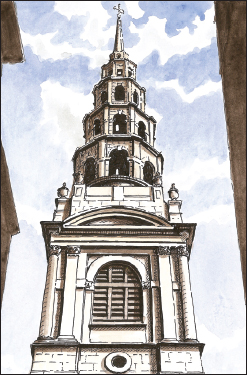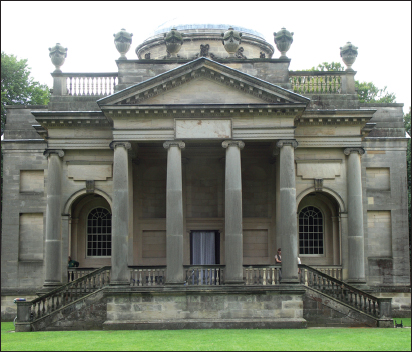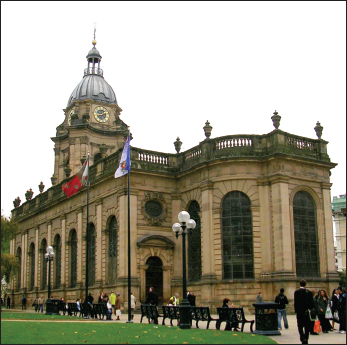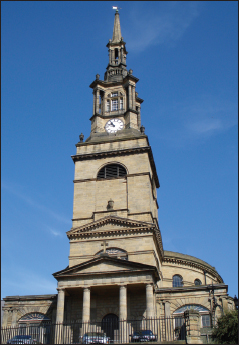CHAPTER 4
 Tudor, Stuart and
Tudor, Stuart and 
Georgian Churches

FIG 4.1 LONGNOR, STAFFS: Georgian churches, like this example dating from 1780, are distinctive by their nave and chancel being all in one huge body with no aisles and the use of Classical forms like columns and round arched windows. Despite the dominance of this style from antiquity, Gothic details as on the tower here at Longnor were used, and increasingly so towards the end of this period.
Henry VIII’s attempts to seek a divorce from his first wife and the subsequent separation from both her and the Catholic Church had a dramatic effect across England.
Although the King had played upon doubts and grievances which already existed towards the clergy, the changes which resulted from the establishment of the Church of England and the Dissolution of the Monasteries during the 1530s must have shocked congregations cut off from the tumultuous Court circles. This Reformation changed the service from a mysterious ceremony performed in Latin and largely out of view behind the rood screen (a wooden or stone barrier between the nave and chancel with a large crucifix, the rood, upon it) to one where a sermon was preached by the priest from his pulpit in their native tongue. Over the next 100 years, during various zealous bouts of destruction by county commissioners and others, the interior of most churches was transformed from a richly coloured, dark and imposing experience to one which was bright and sanitized with whitewashed walls, an open plan, and clear glass in the windows.

FIG 4.2: With the dissolution of the monasteries the old abbey or priory church was often given to the parish. Many of our churches may have originally been monastic but as they might then have been found too large for local needs only a section was used, with the other parts demolished or falling into ruin. Here at Dunstable Priory the nave with its aisles was retained while the central tower (which stood at the right end where the red brick is) and the chancel beyond were knocked down.
The physical structure of most churches now entered a period of stagnation and decline as the driving forces behind medieval rebuilding, like the monasteries, had gone or turned their attention elsewhere. This was particularly true of the local gentry who with the banning of chantry chapels during the Reformation began to lose interest in financing their local church and displayed their steadily increasing wealth upon grand new country houses instead. In most cases later Tudor and Stuart building was limited to replacing parts of churches which had become unsafe or had fallen down. There were few complete churches put up until the devastation caused by the Great Fire of London forced the Commissioners to turn to Sir Christopher Wren to rebuild the 50 or so medieval structures engulfed by the flames.
There were sweeping changes in both village and town during the Georgian period. The setting of the country house became as important as its façade and the creation of great parks resulted in the sweeping away of whole villages, usually leaving the old parish church stranded or rebuilt on a new site. Their crumbling Gothic structures hardly fitted in with the owner’s new Classical mansion so they either added a few of the latest fashionable trimmings like a cupola on the tower or built a new church, retaining little of the old.

FIG 4.3: Sir Christopher Wren (1632–1723) started life, as many early architects did, in another career, in his case as a talented scientist who suddenly after a few amateur designs found himself responsible for the rebuilding of London’s churches in the wake of the Great Fire of 1666. His designs were ingenious and varied from the Baroque masterpiece of St Paul’s Cathedral to his inventive steeples, as in this example from St Bride’s (said to be the inspiration for the modern wedding cake). These were the first Classical places of worship built for the Church of England and set the standard for the next 150 years. At the peak of the rebuilding there were nearly 30 under construction all at the same time and most of the 51 he designed were complete by 1686.

FIG 4.4: A key element in designing parks around country houses was the use of eye catchers or follies, structures which would surprise visitors or mark out the extensive boundary of the owner’s land. Others just wanted to improve the view of their imaginary Roman world – they saw themselves as descendants of Roman nobles and not medieval knights. Like many country house owners Sir Francis Dashwood decided the old medieval church on top of the hill overlooking his new house at West Wycombe was inappropriate and transformed it by rebuilding the nave and tower but leaving the chancel, still the domain of the clergy. He also added a huge golden ball on top in which it is claimed his notorious Hellfire Club could convene.
A rapidly growing, urban population had put pressure upon the Church to respond, but apart from the physical rebuilding of naves and the fitting of galleries inside to increase capacity, they did little for these new congregations’ hearts and minds. This inactivity aided the expansion of dissenting groups like the Methodists and Baptists and the erecting of thousands of chapels, especially in the late 18th and 19th centuries, is a key feature of the new townscapes.
FIG 4.5: Chapels were a distinctive feature of the 18th and 19th centuries. Some, as with this example in the Peak District, were built for remote communities, others were for the new dissenting groups like the Baptists and Methodists. Most were simple, symmetrical structures with a large body, galleries within and simple round arched windows.
The remoteness of many of the clergy towards the changing times was partly because by now it was seen as a position suitable for the sons of aristocrats and gentry. Gone was the poor medieval parish priest bound to celibacy, now he could be a member of the upper classes, a married man who demanded a fine house for his family which was suitable for entertaining the circles in which they mixed. In many towns and villages the most notable church building from this period will be the vicarage!
Tudor, Stuart and Georgian Churches
What little was built in the 100 years after the Reformation was still similar in form to that which preceded it, except square-headed windows were widely used. The most obvious difference, however, was in the use of brick, at this stage usually confined to the south and east but by the 18th century the most common material, even if then it was faced over with stone or rendered to look like it.
With the restoration of the monarchy in 1660, the Classical style which had previously only been tentatively used became dominant and in the aftermath of the Great Fire of London it was mastered by Wren on his churches. The round arch returned with large prominent voussoirs (the segments from which arches are composed) while later ones might have just the central keystone highlighted. Windows were large rectangular grids of clear glass, usually with a semi-circular head, while external walls were composed of fine-cut masonry with some of the more lavish having pilasters (flat columns attached to the wall).
Another notable change was in the form of the nave and chancel. No longer were they required to be separate as the service was now performed directly in front of the congregation, so new churches and chapels erected to meet the demands of a growing population or to replace dilapidated buildings had it all under one roof in a distinctive large rectangular structure. To increase capacity, aisles were not added as in the medieval church but an internal gallery was built down the sides and above the west end (strictly speaking, columns were still used to support the now massive single flat pitched roof and so form aisles up the sides, although not defined as such). Towers were still built on larger churches, some with exuberant stacking of columns and a spire or just a simple cupola on top. The structure below was generally plain with a wide belfry opening, round-arched in most but with a flat point and ‘Y’-shaped tracery on late 18th- and early 19th-century Gothick types (the ‘k’ is added to differentiate this style from Victorian Gothic).

FIG 4.6: Although brick had been used in a few eastern counties like Essex before the Reformation, it was in this period that its use became widespread. In Tudor times it was still regarded as a luxury product and was often cut to form door and window surrounds, as in this 16th-century example. Tudor bricks were handmade, usually on site from local clay; they tend to be thin, irregular and set in a thick line of mortar. By the Georgian period they had become standardized and set in regular bonds but as they became more common were often covered in render to imitate stone.

FIG 4.7: From the late 17th century it became common for the architect who designed an aristocrat’s main residence to have some influence over the church which often stood nearby, as here at Witley Court, Worcs. These were now at the mercy of the owner’s whims and show the latest architectural styles from the flamboyant Baroque to the austere Neoclassical, with the architect replacing the mason as the designer of churches. The use of foreign styles and, towards the end of the period, materials from outside the local area also brought an end to vernacular building.
FIG 4.8: The Baroque was the dominant style in the late 17th and early 18th centuries, as pictured here at St Philip’s Cathedral, Birmingham (consecrated as a parish church in 1715). Giant pilasters, tall windows, balustraded parapets with vases, and exuberant decoration are key features.

FIG 4.9: Palladian architecture was popular in the mid-18th century, as here at Gibside, County Durham, dating from the 1760s. It was a more refined style, concentrating on correct proportions rather than rich decoration.
FIG 4.10: In the late 18th and early 19th centuries the Neoclassical style influenced church building, as in this example from Buxton, Derbys. Classical forms were used in new ways and buildings can appear austere with decoration often limited to towers and large porticos across the end of the building (the one in the right of this picture was later filled in).

FIG 4.11: Despite the domination of Classical styles, Gothic forms were used, at first inaccurate replications of details applied to a Classical building as in this example from Stone, Staffs, with the distinctive ‘Y’-shaped window tracery. By the early 19th century it became more than just a decoration.

FIG 4.12 EXEMPLAR CHURCH c1800: Although the village has grown, once again the church remains much as before and signs of neglect are visible. A new round-arched porch and a cupola on top of the tower are the only additions, although a fine new vicarage has been built behind the churchyard and a manor house to the right.
STILL OUT THERE

FIG 4.13 MACCLESFIELD, CHESHIRE: Most Georgian churches were built as part of a country estate or to service expanding new towns as here at Christchurch, Macclesfield, opened in 1776. In this period, buildings like this were usually paid for by local gentry or industrialists: it was Charles Roe, who is regarded as the founder of the town’s silk industry, who financed this structure which looms over the neighbouring terraces. It is a standard Classical form but with an exceptionally tall tower featuring a Gothic-style ogee arch belfry opening.

FIG 4.14 ST CHAD’S, SHREWSBURY: The neglect of churches during the 17th and 18th centuries left many in a perilous state. Therefore, when a young engineer called Thomas Telford was asked to inspect the medieval St Chad’s church in Shrewsbury, the congregation should not have been surprised when he told them it was about to collapse! They ignored his advice and while he went on to international fame, the church lasted barely six months before, as he had predicted, the tower fell down and destroyed the building! The new structure in a Neoclassical style was completed in 1792 and was one of a number with round naves from this period.
FIG 4.15 NORTH RUNCTON, NORFOLK: As with many churches in this period, they were only built when the old one had finally collapsed, as happened here when its predecessor’s steeple fell down. The new building completed in 1713 has a square nave with a central projection with pediment above and a lantern on top of the tower.

FIG 4.16 COWLINGE, SUFFOLK: It is often only part of a church which was rebuilt in this period, as in this case where a new brick tower was built in 1733 at the west end of the medieval church.

FIG 4.17 ALDGATE, LONDON: St Botolph’s was designed by George Dance and completed in 1744, with its inventive stacking of Classical details but less exuberant than Wren’s earlier Baroque. As with many churches in this period, it is not aligned on an east-west axis but in this case runs north-south due to the road which it is built within.
FIG 4.18 NEWCASTLE UPON TYNE: All Saints’ church was designed by David Stephenson and completed in 1796. This Neoclassical church has an elliptical nave (see Fig 4.14), a portico on four columns across the entrance and low segmental arched windows to the sides which are characteristic of this style.

FIG 4.19 WITLEY COURT, WORCS: A spectacular Rococco interior in white and gold which dates from the mid-18th century. Georgian churches were always spacious and light.




